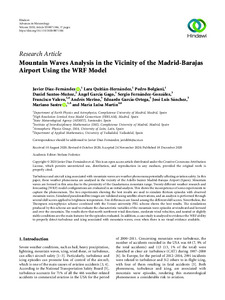Por favor, use este identificador para citar o enlazar este ítem:
http://hdl.handle.net/20.500.11765/12681
Mountain waves analysis in the vicinity of the Madrid-Barajas Airport using the WRF model
| Título : | Mountain waves analysis in the vicinity of the Madrid-Barajas Airport using the WRF model |
| Autor : | Díaz Fernández, Javier; Quitián Hernández, Lara; Bolgiani, Pedro; Santos Muñoz, Daniel


|
| Palabras clave : | Turbulence; Aircraft icing; Mountain waves; WRF model |
| Fecha de publicación : | 2020 |
| Editor: | Hindawi |
| Citación : | Advances in Meteorology. 2020, p. 1-17 |
| Versión del editor: | https://dx.doi.org/10.1155/2020/8871546 |
| Resumen : | Turbulence and aircraft icing associated with mountain waves are weather phenomena potentially affecting aviation safety. In this paper, these weather phenomena are analysed in the vicinity of the Adolfo Su´arez Madrid-Barajas Airport (Spain). Mountain waves are formed in this area due to the proximity of the Guadarrama mountain range. Twenty different weather research and forecasting (WRF) model configurations are evaluated in an initial analysis. .is shows the incompetence of some experiments to capture the phenomenon. .e two experiments showing the best results are used to simulate thirteen episodes with observed mountain waves. Simulated pseudosatellite images are validated using satellite observations, and an analysis is performed through several skill scores applied to brightness temperature. Few differences are found among the different skill scores. Nevertheless, the .ompson microphysics scheme combined with the Yonsei university PBL scheme shows the best results. .e simulations produced by this scheme are used to evaluate the characteristic variables of the mountain wave episodes at windward and leeward and over the mountain. .e results show that north-northwest wind directions, moderate wind velocities, and neutral or slightly stable conditions are the main features for the episodes evaluated. In addition, a case study is analysed to evidence the WRF ability to properly detect turbulence and icing associated with mountain waves, even when there is no visual evidence available. |
| Patrocinador: | .is work was partially supported by the following research projects: PID2019-105306RB-I00, PCIN-2014-013-C07-04, and PCIN2016-080 (UE ERA-NET Plus NEWA Project), CGL2016-78702-C2-1-R and CGL2016-78702-C2-2-R (SAFEFLIGHT Project), FEI-EU-17-16 and SPESMARTand SPESVALE (ECMWF Special Projects). |
| URI : | http://hdl.handle.net/20.500.11765/12681 |
| ISSN : | 1687-9309 |
| Colecciones: | Artículos científicos 2019-2022 |
Ficheros en este ítem:
| Fichero | Descripción | Tamaño | Formato | ||
|---|---|---|---|---|---|
| DiazFernandez_Mountai... | 6,69 MB | Adobe PDF |  Visualizar/Abrir |
Los ítems de Arcimis están protegidos por una Licencia Creative Commons, salvo que se indique lo contrario.





